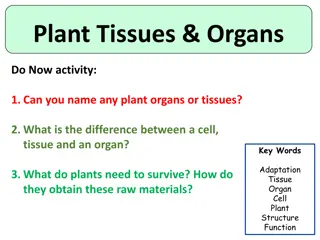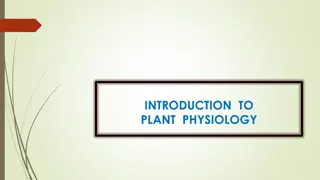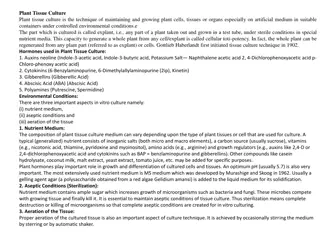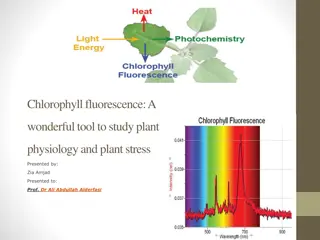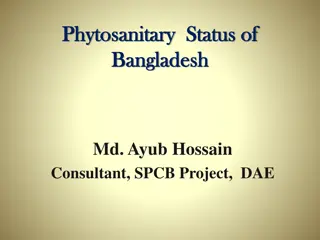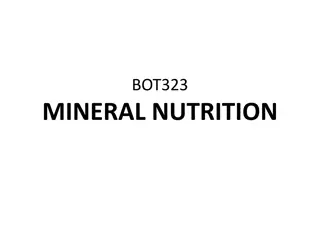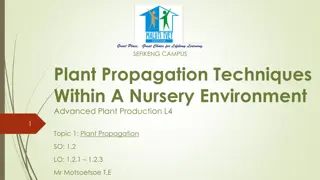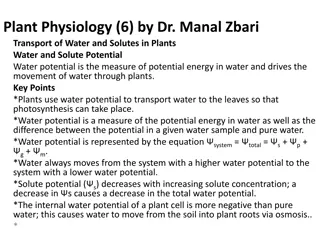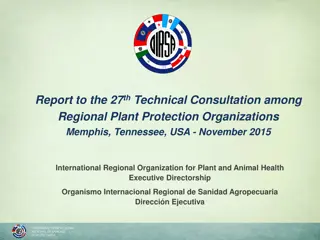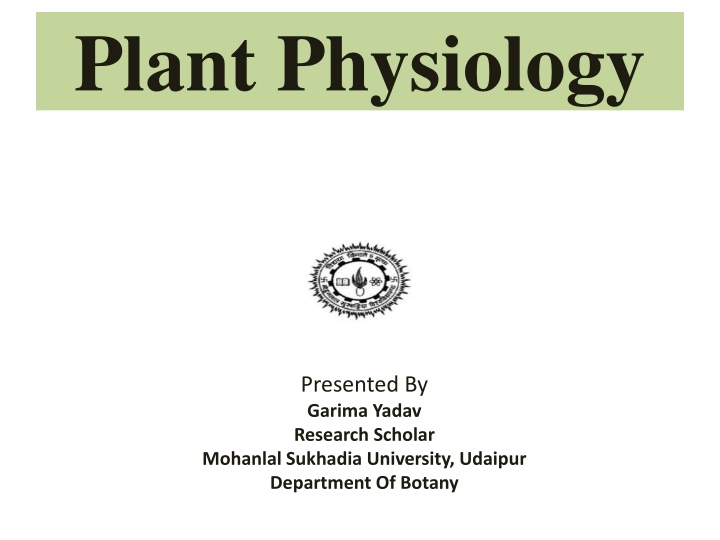
Plant Senescence: A Vital Developmental Process
Senescence is a crucial phase in plant development involving the regulated breakdown of cellular components to recycle resources for plant growth and survival. It is a genetically controlled process marked by changes in gene expression and biochemical events. Various levels of senescence exist in different plant species, playing essential roles in their life cycles. This article delves into the dynamics, types, and genetic regulation of senescence in plants.
Download Presentation

Please find below an Image/Link to download the presentation.
The content on the website is provided AS IS for your information and personal use only. It may not be sold, licensed, or shared on other websites without obtaining consent from the author. If you encounter any issues during the download, it is possible that the publisher has removed the file from their server.
You are allowed to download the files provided on this website for personal or commercial use, subject to the condition that they are used lawfully. All files are the property of their respective owners.
The content on the website is provided AS IS for your information and personal use only. It may not be sold, licensed, or shared on other websites without obtaining consent from the author.
E N D
Presentation Transcript
Plant Physiology Presented By Garima Yadav Research Scholar Mohanlal Sukhadia University, Udaipur Department Of Botany
Senescence Senescence is the final phase of plant vegetative and reproductive development, preceding the widespread death of cell and organs. Energy dependent developmental process that is controlled by plant s own genetic program. Senescence recovers a portion of the valuable resources that the plant invested in leaf formation. During senescence hydrolytic enzymes break down may cellular proteins, carbohydrates and nucleic acids. The component sugar, nucleosides and amino acids are then transported back into the plant via phloem, where they will be reused for synthetic processes. Involves structural, biochemical and molecular changes. Accelerated by both biotic and abiotic factors.
Senescence Dynamic closely regulated developmental process. Involves highly coordinated changes in gene expression. Requires active gene transcription and translation. The branch of botany that studies ageing, senescence and abscission in plants is called as phytogerontology.
Various levels of Senescence Whole Plant Senescence: In plants such as wheat, rice, gram and mustard the plants die after seed production. This is also observed in monocarpic plants which live for several years but flower only once in their life time as in sago palm and bamboos. Sequential Senescence In perennial plants, the tips of the main shoot remain meristematic. It is the progressive senescence of older leaves and lateral organs which may occur at any time of the year. The tips of the main shoot continue to produce new buds and leaves. Shoot Senescence In certain herbaceous perennials such as banana and gladiolus, the above the ground part of the shoot dies each year after flowering and fruiting but the underground parts (stem and roots) survive and put out new shoots the next year. Synchronous Senescence In temperate deciduous trees such as elm and maple, all the leaves senesce and fall at certain seasons of the year like late autumn in October. This is also called as simultaneous senescence. It is controlled by environmental factors.
Senescence is an Ordered Series of Cytological and Biochemical events It is genetically encoded and follows a predictable course of cellular events. Chloroplast is the first organelle destruction of thylakoid protein components and stromal enzymes. (Because a large portion of nitrogen in a leaf cell is in the chloroplast) Nuclei remain structurally and functionally intact until the late stages of senescence. (To accomplish the recycling process) Various catabolic processes occur in senescing tissues and de novo synthesis of hydrolytic enzymes, such as protease, nucleases, lipases and chlorophyll degrading enzymes. The level of most leaf m-RNA decline significantly during senescence phase. Genes whose expression reduces during senescence are called senescence down regulated genes (SDGs) Genes whose expression is induced during senescence are senescence associated genes. (SAGs) to deteriorate, with the
Senescence characterized by changes including: Cessation of photosynthesis. Disintegration of chlorophyll structure. Intensive loss of chlorophyll, proteins. Up regulation of tonoplast localized cytochromes. Increase in lipid peroxidation. Vacuolar autophagy. Membrane leakage. Disruption of membranes leading to cellular decompartmentalization, loss of tissue structure. Proteolytic activity. Protease gene expression. Poly -Galactouronidase activity. Nuclease activity. Nuclear degradation.
Environmental And Autonomous (internal) Regulation of Leaf Senescence Various environmental cues and autonomous factors regulate leaf senescence but limited water and nutrient availability (especially nitrogen) are major factors. Shading of lower leaves under a canopy is another factor. > light that has passed through a canopy of leaves has lower ratio of red to far-red light as a result of preferential absorbance of red photons by chlorophyll in upper leaves. > Reduced PAR and a decreased red/far-red ratio are the senescence triggering signals. Leaf age has major influence on the initiation of senescence. Its initiated when the photosynthetic rate drops below a threshold which may be at or near the compensation point at which the leaf no longer contributes fixed carbon to the rest of the plant.
Molecular Genetic Manipulation Of Leaf Senescence Current molecular genetic strategies to manipulate leaf senescence are based on phytoharmone physiology. Cytokinins o Cytokinins can inhibit leaf senescence. The endogenous cytokinin level drops with the progression of leaf senescence. o The first committed and controlling step in the cytokinin biosynthetic pathway is catalyzed by IPT ( Iso pentenyl Transferase). Expression of this enzyme will result in production of cytokinin. o In transgenic plants with manipulated IPT constructs exhibit some delay in leaf senescence but it may also influence many developmental processes, and overproduction of cytokinins before senescence will interfere with normal plant development. o To avoid this problem, the highly senescence-specific SAG12 promoter was used to direct IPT expression. This promoter activates the expression of IPT in leaves only at the onset of senescence.
Molecular Genetic Manipulation Of Leaf Senescence Autoregulated production of cytokinins
Ethylene Ethylene treatment often promotes senescence. Leaf senescence can be interfered by blocking ethylene production or perception in transgenic plants. Transgenic tomato plants expressing antisense genes that inhibit either of two ethylene biosynthetic enzymes, ACC synthase or ACC oxidase, showed significantly reduced production of ethylene and retarded senescence of fruits and leaves. The levels of Ethylene increase during senescence. One of the genes that is thought to be a regulator of ethylene induced senescence in Arabidopsis leaves is etr1. This etr1 is mutated, which renders plant insensitive to ethylene.
Hormonal control Abscisic acid and auxins also impart effect on the senescence. Major ways-control-plants Hormone biosynthesis Signaling pathways
Other Hormones that Delay Senescence Auxin o Reduce ethylene sensitivity. o The levels of auxin increase during leaf senescence, and many genes involved in auxin biosynthesis such as tryptophan synthase are up regulated during age dependent senescence. o Other genes that may be involved in the regulation of leaf senescence by the plant hormone auxin in Arabidopsis include ARF2, transcript levels of which are increased during leaf senescence. o It retard soya bean senescence (leyser, 2004) Gibberalic acid Delay senescence in some cut carnation flowers by acting as antagonist to ethylene.
Other Hormones that Induce Leaf Senescence Abscisic Acid o Related to seed development and seed germination. o Ion leakage. o Change in lipid peroxidation o Some of the key Abscisic acid biosynthesis genes are known to be up regulated when senescence is occurring; these include NECD( 9-cis-epoxycarotenoid dioxygenase) and aldehyde oxidase genes. o Expression of novel Dnases and RNases . o Plant hormone abscisic acid is able to increase H2O2 levels (either by production or accumulation) in leaves and that this accelerates the senescence process. Jasmonates o Increase senescence.
Polyamines Effective anti-senescence agents. Retard chlorophyll loss, membrane deterioration. Increase in Rnase and protease activities.
Significance of Senescence Old and inefficient organs are replaced by young and developing organs. Recovery of nutrients from senescing organs by diverting the nutrients to the younger parts where they are utilized as reserve materials. Leaf fall adds leaf material and its break down products to the soil, which are again used by the plants for their growth. Shoot senescence is a mechanism to help the plants perennate during the unfavorable periods. Simultaneous or synchronous leaf fall occurs in autumn prior to winter. It reduces transpiration, which is essential for survival in winter, when the soil is frozen and roots cannot absorb water.





